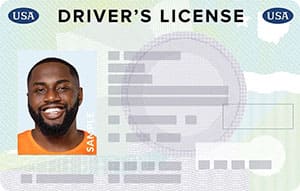- 0 Incorrect (4 allowed to pass)
- 0 Correct
- Updated for February 2025
- Based on official Vermont Driver's manual
Free Vermont DMV Permit Practice Test 2025
Interested in obtaining your Vermont learner’s permit? We make the process much easier for you. First, you must pass the vision screening and a written permit knowledge test. The test consists of 20 multiple-choice questions covering traffic laws, road signs, safe driving practices, driving under the influence, and what to do in case of an accident, as outlined in the state’s Vermont DMV 2025 Driver’s Manual. To pass, you must score at least 80% (16 out of 20 questions) and testing must take place in person at the DMV. Failing the test means waiting until the next business day and a retesting fe, so use our practice resources to make sure that doesn’t happen.
The Vermont Graduated Driver’s License (GDL) program gradually introduces driving privileges to minors, beginning with the learner’s permit granted to teens at least 15 years of age. With this, the teen driver is allowed to drive when accompanied by a licensed driver who is at least 25 years old. This higher age restriction is not applicable to a parent/guardian or course instructor. After holding the learner’s permit for at least 12 months, with no violations for six months, drivers aged 16 or 17 who have completed their driver education course and passed the road test can apply for a junior driver’s license. One special note: in Vermont, individuals under 18 cannot operate a vehicle in the course of work employment (pizza delivery, etc.) unless they have held a junior driver’s license for at least one year.
Updated for February 2025, our free online Vermont Permit Practice Test is designed to simulate real exam conditions with questions and answers based on the state manual. We provide instant feedback for incorrect responses, which has been shown to speed the learning process. Once you’re ready, go to the DMV with proof of identity (birth certificate, U.S. passport), proof of social security number (Social Security card, a W-2, or a pay stub with your Social Security number on it), proof of Vermont residency (recent utility bill, rental agreement, or official document with address on it), and a signed parental consent form if you’re under 18. Submit the documents, pass a vision screening, pay the fee, and take the official written test.
Please check out our other free Vermont DMV permit practice tests!
[faq]
FAQs
Can I take the permit test online?
In Vermont, you can take the permit test online through the Vermont Department of Motor Vehicles’ online testing portal. This option is available for convenience and accessibility.
What are the requirements for a learner’s permit?
To get a learner’s permit in Vermont, you need to be at least 15 years old, pass a vision and knowledge test, and provide proof of identity, residency, and parental consent if under 18.
How much does the permit test cost?
The fee for the Vermont learner’s permit test is $20. This fee includes the cost of the knowledge test and the issuance of the permit.
How long is the learner’s permit valid?
A learner’s permit in Vermont is valid for two years. If your permit expires, you will need to retake and pass the knowledge test to renew it.
Can I get a driver’s license at 18 without a prior permit?
Yes, in Vermont, you can apply for a driver’s license at 18 without having previously held a learner’s permit. However, you must pass the written test, vision test, and road test.
Can I drive alone with a permit?
No, in Vermont, you cannot drive alone with a learner’s permit. You must be accompanied by a licensed and unimpaired driver who is at least 25 years old.
[/faq]
- Perfect for learner’s permit, driver’s license, and Senior Refresher Test
- Triple-checked for accuracy
What you need to know

What to expect on the actual VT DMV exam
questions
correct answers to pass
passing score
minimum age to apply
Helpful links
List of questions (classic view)
- Flashing arrow panels may be used in work zones to
- When you wish to turn left, you should start signaling _________ in advance to alert other drivers.
- When a train is approaching a railroad crossing, you must stop at least ________ from the nearest rail.
- What does this sign indicate?
- When two or more lanes are going in the same direction, a broken white line is used
- You are driving on an undivided roadway. A school bus with flashing red lights is stopped ahead. What must you do?
- When visibility is poor, such as in fog, heavy rain, or heavy snow, you should use your
- What does this signal indicate?
- Under poor driving conditions, you should maintain a following distance of
- Vermont law requires you to turn on your headlights whenever you cannot clearly see persons or vehicles
- To recover from a skid, what should you do?
- This sign indicates
- If you miss your exit on a freeway, what should you do?
- Under Vermont law, which occupants of a passenger car must wear safety belts or appropriate child restraints?
- _________ are areas around trucks or other large vehicles in which other vehicles may disappear into blind spots.
- This sign indicates that
- You are traveling on a two-lane road. If a vehicle ahead of you stops for a pedestrian, you must
- To avoid being temporarily blinded by an oncoming vehicle's headlights, you should look toward
- A vehicle parked on a one-way road must be parked within ________ of the curb or the side of the road.
- What does this sign mean?
More resources
- Alabama: Test 1 / Test 2
- Alaska: Test 1 / Test 2
- Arizona: Test 1 / Test 2
- Arkansas: Test 1 / Test 2
- California: Test 1 / Test 2
- Colorado: Test 1 / Test 2
- Connecticut: Test 1 / Test 2
- Delaware: Test 1 / Test 2
- District of Columbia: Test 1 / Test 2
- Florida: Test 1 / Test 2
- Georgia: Test 1 / Test 2
- Hawaii: Test 1 / Test 2
- Idaho: Test 1 / Test 2
- Illinois: Test 1 / Test 2
- Indiana: Test 1 / Test 2
- Iowa: Test 1 / Test 2
- Kansas: Test 1 / Test 2
- Kentucky: Test 1 / Test 2
- Louisiana: Test 1 / Test 2
- Maine: Test 1 / Test 2
- Maryland: Test 1 / Test 2
- Massachusetts: Test 1 / Test 2
- Michigan: Test 1 / Test 2
- Minnesota: Test 1 / Test 2
- Mississippi: Test 1 / Test 2
- Missouri: Test 1 / Test 2
- Montana: Test 1 / Test 2
- Nebraska: Test 1 / Test 2
- Nevada: Test 1 / Test 2
- New Hampshire: Test 1 / Test 2
- New Jersey: Test 1 / Test 2
- New Mexico: Test 1 / Test 2
- New York: Test 1 / Test 2
- North Carolina: Test 1 / Test 2
- North Dakota: Test 1 / Test 2
- Ohio: Test 1 / Test 2
- Oklahoma: Test 1 / Test 2
- Oregon: Test 1 / Test 2
- Pennsylvania: Test 1 / Test 2
- Rhode Island: Test 1 / Test 2
- South Carolina: Test 1 / Test 2
- South Dakota: Test 1 / Test 2
- Tennessee: Test 1 / Test 2
- Texas: Test 1 / Test 2
- Utah: Test 1 / Test 2
- Vermont: Test 1 / Test 2
- Virginia: Test 1 / Test 2
- Washington: Test 1 / Test 2
- West Virginia: Test 1 / Test 2
- Wisconsin: Test 1 / Test 2
- Wyoming: Test 1 / Test 2
Your go-to, trusted source
Experience the Driving-Tests differenceOur commitment to accuracy and quality in our practice tests
Explore our rigorous, multi-tiered verification process that ensures each question mirrors the official manual for unparalleled accuracy.

At Driving-Tests.org, we understand the importance of reliable and accurate practice tests to help you prepare for your DMV exam. That's why we've developed a meticulous process to create and continually update our practice questions, ensuring they reflect the most current driving laws and regulations.
Here's an inside look at how we maintain the highest quality in our practice tests.
Content Creation and Verification Process
- Alignment with Official Manuals:
Every question we develop is based on the most recent version of each state's official driving manual. Our team regularly monitors each state DMV's website for the latest updates to ensure our practice tests are always aligned with the most current information. - Community Feedback Integration:
We leverage feedback from our vast community of users to understand which topics are most frequently tested. This helps us focus on the areas that are most relevant and beneficial for your preparation. - Expert Content Creation:
Our in-house editor, Steven, who has extensive experience in driver education, crafts each question with precision. He conducts a thorough review of each question against the official manuals to ensure accuracy. - Rigorous Review Process:
Once Steven has finalized a set of questions, our team conducts a joint review session. This second level of scrutiny involves content accuracy, proofreading, and fact-checking to eliminate any errors. - User Feedback Mechanism:
After a question goes live on our site, we keep the lines of communication open. Each question features a feedback button, inviting users to report any issues or errors. This continuous feedback loop allows us to address and rectify any concerns promptly. - Responsive Updates:
In line with our commitment to accuracy, we quickly update our practice questions to reflect any changes in the DMV manuals. Additionally, we update the free electronic copy of the state's driver's license manuals on our site, typically within a few days after the DMV publishes them.
Our thorough quality control process ensures that you have access to practice tests that are as accurate and up-to-date as possible. We believe in the power of well-prepared drivers and are dedicated to providing you with the best study tools to help you succeed on your DMV exam.
Unlock Your Best Chance to Pass
Get instant access to 650+ exam-like questions tailored for VT.
See how Premium can help you pass faster, risk-free, with our 97% success rate.
Vermont questions seen on the real test
Questions specific to your state. Breeze through your exam with the right tools.
97% of Premium users pass the first time
Compare with the average passing rate of just 49%.
Premium users succeed.Trusted by over 1.15 million customers
The only program recommended by DMVs nationwide.





